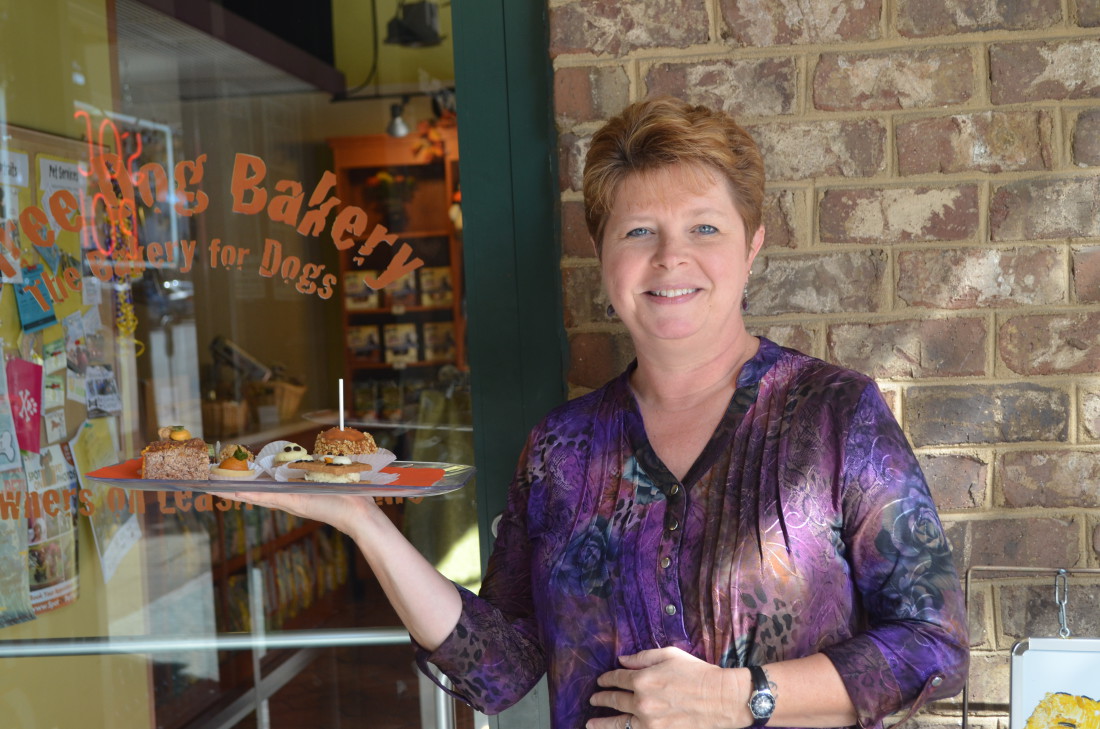Ashevilleans love their pets about as much as they savor the city’s great food scene. A stroll downtown in nice weather finds businesses offering bowls of water and baskets of free doggie treats while plenty of canine companions lounge with their humans on café patios.
So it makes sense that residents of our health-conscious and foodie town would want their animal friends to eat the very best. And for locals with a do-it-yourself spirit, that could mean preparing custom-made pet food at home.
Waste not
For Asheville pet owner Mike Vines, an interest in cooking homemade food for his three mixed-breed dogs emerged three years ago with the purchase of a rotisserie chicken and a desire to eliminate food waste. “Our basset hound mix, who’s 10, as he’s gotten older, he’s gotten more picky about his food,” says Vines. “I try to use all the parts of the food — we have almost zero food waste at the house — so I boiled down the rest of the chicken and started making homemade dog food in small batches, and he really liked it. Then the other dogs got jealous, so we just decided to make big batches for everyone.”

Separating the meat from the bones with chicken is “kind of an intensive process,” says Vines, who has worked in the past as a line cook with local restaurants. But he points out that he rotates proteins, sometimes offering turkey or beef as well. He mixes the meat and a bit of fat with brown rice and some vegetables, including peas, carrots or green beans, so that two-thirds of the recipe is protein.
Vines didn’t change his dogs’ diet without boning up on some nutritional facts. He started with canine dietary information he found online with the American Kennel Club and also consulted YouTube videos. “There are some very basic golden rules, like using a certain percentage of protein and a certain percentage of starch. If you want to throw in vegetables, there are ratios for that,” he says.
He also serves his gourmet feast as a once-daily accompaniment to commercial grain-free kibble, which the dogs may access freely throughout the day. His two 50-pound dogs get about half a cup of homemade food once a day, and the 10-pound pup gets about 2 tablespoons daily.
“I certainly wasn’t going to just switch up their entire diet or anything like that,” he says. “I know their stomachs can be really sensitive. I didn’t just blindly do this. I did my research.”
The right balance
Denise Henry, a veterinarian with the Charlotte Street Animal Hospital, agrees that inquiry and attention to detail are crucial for aspiring pet-food chefs. “It is possible for owners to make a complete and balanced diet at home,” she says. “However, it’s not an easy thing to do. To ensure the correct balance of vitamins, minerals, proteins, fats and carbohydrates in each meal, the recipe must be followed exactly. No substitutions or changes to the recipe are allowed.”
Joseph Bartges, a professor with the University of Georgia College of Veterinary Medicine and a widely respected expert on pet nutrition, speaks to this in his publication Raw or War: Homemade and Raw Food Diets. “It is possible to achieve the same nutrient balance with a homemade food as with a commercially prepared food. However, this largely depends on the accuracy and competence of the person formulating the food, and on the compliance and discipline of the owner,” he writes. “There are common nutrient problems in many homemade foods. Many formulations contain excessive protein but are deficient in calories, calcium, vitamins and microminerals.”
Henry always recommends that both dog and cat owners reference diets formulated by a veterinary nutritionist, such as the plans available at petdiets.com and balanceit.com. She also suggests consulting the University of Tennessee’s online service for creating homemade diets at avl.mx/33g.
Also of great importance is knowing what not to use. “Garlic, onions, grapes, raisins, chocolate and macadamia nuts are all toxic to pets,” she says.
But the main concern about making pet food from scratch, says Henry, is that over time, it’s easy to fall away from following the recipe precisely. “An owner may not be able to find the right ingredient so they switch it out for something else. That may not be a big deal for two or three days, but, over time, if substitutions continue or folks get tired of using the scale and begin to eyeball the ingredients, then the health of the pet may be suffer because it is not eating a properly balanced diet,” she says.
She adds that pets face the same risks as humans for salmonella and E. coli infections when consuming raw or undercooked eggs and meats. “We do not recommend raw diets due to concerns of bacteria — both for the pet and the owner,” she says.
Treat your pet
If making cat or dog chow seems too complicated and time-consuming, baking treats might be a good alternative. “I think using homemade treats is a wonderful idea,” says Henry. “It can help owners feel like they are doing something special for their pet, and, in turn, strengthen the human-animal bond.”
She again cautions against common pet toxins (a full list is available online from the American Society for the Prevention of Cruelty to Animals at avl.mx/33h) but says selecting one of the numerous treat recipes available on the internet should be fine.
At downtown’s Three Dog Bakery, owner Tom Flora creates colorful and intricately sculpted goodies for dogs that are pretty enough to rival the fanciest offerings in Asheville’s human-focused pastry shops. Although he’s not able to use meat as an ingredient in his Department of Agriculture-inspected production facility, Flora uses rice flour, peanut butter, honey, applesauce, carob and other natural ingredients to make treats that are both attractive and tasty for canines.
Flora, who has three dogs of his own, advises home treat-bakers to eschew synthetic ingredients. “What I would avoid is going to Bed, Bath & Beyond or any of those stores where you would get food colorings to do icings and so forth — stay away from those,” he says. “What we use for coloring is all-natural.
“For example, reds we do with beet powder, yellows we do with turmeric, we use spinach powder to make green coloring,” he continues. “A lot of human-type colorings out there are going to have some type of dye or sugar content that would be harmful to the dog. Dogs shouldn’t be eating refined sugars.”
Three Dog Bakery stocks a selection of doggie cookie cutters, and the shop has published two recipe books — Cooking the Three Dog Bakery Way and the Three Dog Bakery Cookbook. Both are currently out of stock at the shop, but they are available at Amazon.com. The recipes, Flora says, range from a meatloaf to little cookies and cakes.
Henry says she doesn’t think there are hard-and-fast rules when it comes to how many treats one should give a pet. “Just like for us, a cookie or ice cream here or there is nothing to worry about, but we don’t want those unhealthy calories to be more than 5 to 10 percent of our daily intake,” she says, noting that the average 20-pound dog only needs 400 calories a day to maintain a healthy body weight.
Charlotte Street Animal Hospital offers information about canine nutrition on its website at avl.mx/33f. Three Dog Bakery is at 21 Battery Park.





Before you comment
The comments section is here to provide a platform for civil dialogue on the issues we face together as a local community. Xpress is committed to offering this platform for all voices, but when the tone of the discussion gets nasty or strays off topic, we believe many people choose not to participate. Xpress editors are determined to moderate comments to ensure a constructive interchange is maintained. All comments judged not to be in keeping with the spirit of civil discourse will be removed and repeat violators will be banned. See here for our terms of service. Thank you for being part of this effort to promote respectful discussion.